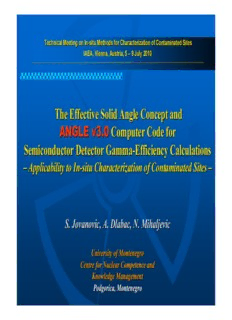
The Effective Solid Angle Concept and ANGLE v3.0 Computer Code for Semiconductor Detector ... PDF
Preview The Effective Solid Angle Concept and ANGLE v3.0 Computer Code for Semiconductor Detector ...
TTeecchhnniiccaall MMeeeettiinngg oonn IInn--ssiittuu MMeetthhooddss ffoorr CChhaarraacctteerriizzaattiioonn ooff CCoonnttaammiinnaatteedd SSiitteess IIAAEEAA,, VViieennnnaa,, AAuussttrriiaa,, 55 –– 99 JJuullyy 22001100 ________________________________________________________________________________________________________________________________________________________________________________________________________________________________________________________________________________________________________________________ TThhee EEffffeeccttiivvee SSoolliidd AAnnggllee CCoonncceepptt aanndd AANNGGLLEE vv33..00 CCoommppuutteerr CCooddee ffoorr SSeemmiiccoonndduuccttoorr DDeetteeccttoorr GGaammmmaa--EEffffiicciieennccyy CCaallccuullaattiioonnss –– AApppplliiccaabbiilliittyy ttoo IInn--ssiittuu CChhaarraacctteerriizzaattiioonn ooff CCoonnttaammiinnaatteedd SSiitteess –– SS.. JJoovvaannoovviicc,, AA.. DDllaabbaacc,, NN.. MMiihhaalljjeevviicc UUnniivveerrssiittyy ooff MMoonntteenneeggrroo CCeennttrree ffoorr NNuucclleeaarr CCoommppeetteennccee aanndd KKnnoowwlleeddggee MMaannaaggeemmeenntt PPooddggoorriiccaa,, MMoonntteenneeggrroo GGaammmmaa--EEnneerrggyy PPeeaakk EEffffiicciieennccyy In any gamma-spectrometric (quantitative) measurement with semiconductor detectors, the question of converting the number of counts - collected by multichannel analyser (MCA) in a full energy peak - into the activity (concentration) of the sample/source cannot be avoided. There are, in principle, three approaches to this issue, as follows. 1) Relative, where one tries to imitate as good as possible the source by a standard (or vice versa), while keeping the same counting conditions for the two. Paid enough care, the result is, in general, so accurate that cannot be surpassed by other methods. However, we all know what "enough care" means in practice. Combined with the inflexibility in respect with varying source&container parameters (shape, dimensions, material composition), this represents raison d'être of the other approaches, as follows. 2) Absolute calculations (Monte Carlo methods) yield full ε ε energy peak efficiency ( ) or total efficiency ( ) for a p tot given counting arrangement. It is essentially statistical treatment of the events which photons undergo - from being emitted by a source atom until the interaction with the detector active body - including the treatment of the so produced electrons, positrons and other subsequent energy carriers. Absolute approach is beautifully exact, on condition that we consider sufficiently large number of incident photons and that we know all the details about - source, detector and intercepting layers‘ geometrical and compositional data - the corresponding photon attenuation coefficients - energy and angle dependent cross section for various photon interactions with the detector active body, and - parameters characterizing electron/positron behaviour in the latter At present, inherent statistical uncertainty of Monte Carlo methods, unsatisfactory manufacturers' detector specifications and relatively poor knowledge of the above physical parameters (some of) are limiting factors for its applicability. 3) Semiempirical models, trying to conciliate the previous two. Semiempirical models commonly consist of two parts: - experimental (producing one kind or another of reference efficiency characteristic of the detector) and ε - relative-to-this (‘efficiency transfer” – ET) calculation of p Inflexibility of the relative method is avoided in this way, as well as the demand for some physical parameters needed in Monte Carlo calculations. ε ET contributes significantly to error compensation in . p Numerous variations exist within this approach, with emphases either to experimental or to computational part. Most of them simplify (or oversimplify) the physical model behind, i. e. the treatment of - gamma-attenuation - geometry and - detector response It was shown earlier (within the development of the k0-NAA method) that only simultaneous differential treatment of these three factors is essentially justified. This fact is transformed into the concept of the effective solid angle - a calculated value incorporating the three components, and closely related to the detection efficiency. TThheeoorreettiiccaall TToo tthhee ddeeffiinniittiioonn ooff tthhee eeffffeeccttiivvee ssoolliidd aannggllee (( )) TThheeoorreettiiccaall GGiivveenn aa ggaammmmaa--ssoouurrccee aanndd aa sseemmiiccoonndduuccttoorr ddeetteeccttoorr,, tthhee eeffffeeccttiivvee ssoolliidd aannggllee iiss ddeeffiinneedd aass:: wwiitthh VV == ssoouurrccee vvoolluummee,, SS == ddeetteeccttoorr ssuurrffaaccee eexxppoosseedd ttoo SS DD tthhee ssoouurrccee ((""vviissiibbllee"" bbyy tthhee ssoouurrccee)) aanndd Here T is point varying over VS, P point varying over SD, and nu the external unit vector normal to infinitesimal σ area d at S . Eq. (1) is thus a five fold integral. D Factor F accounts for gamma attenuation of the photon att following the direction TP out of the detector active zone, while F describes the probability of an energy eff degradable photon interaction with the detector material (i.e. coherent scattering excluded), initiating the detector response. The two factors include therefore geometrical and compositional parameters of the materials traversed by the photon.
Description: